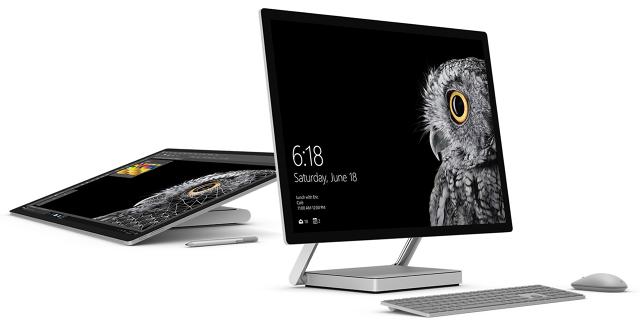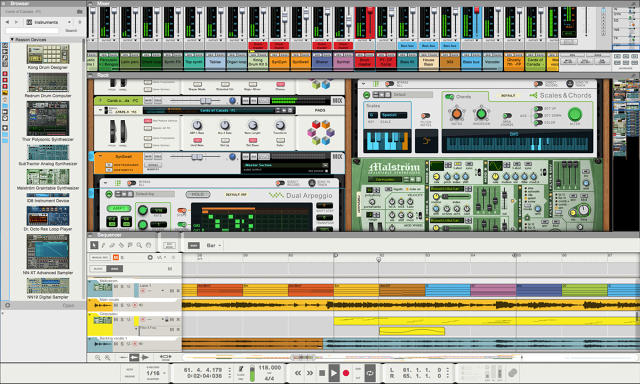Maybe Microsoft Isn’t Ignoring Musicians After All
As a lifelong musician, at first I felt slighted by Microsoft’s newfound emphasis on creativity.
The upcoming Surface Studio desktop is a clear nod to visual artists, with a massive touch screen for sketching, painting, and graphic design, while the knoblike Surface Dial peripheral seems perfect for tool selection in Photoshop. Both devices will be buttressed by the Windows 10 Creators Update, which includes new programs for 3D modeling and drawing. Those announcements seemed to leave musicians out of the picture, so I asked makers of music software and digital audio devices whether Microsoft had been neglecting them.
It turns out the answer is no. Instead of feeling abandoned, musicians are intrigued by the new hardware and encouraged by recent under-the-radar improvements for musicians in Windows 10. As a result, Windows could soon do for musicians what it appears to be doing for artists, even if Microsoft hasn’t done much to publicize it.
Captive Audience
With digital music, one of the biggest concerns is making sure the software communicates properly with keyboards, mixers, and other gear. This requires having the right drivers, which Microsoft traditionally hasn’t done a great job of providing.
But Ernst Nathorst-Böös, CEO of Propellerhead (maker of the popular recording software Reason), says Microsoft is now addressing these issues in Windows 10. In September, the company started testing native support for low-latency USB audio so musicians won’t have to rely on a litany of third-party drivers for their gear.
“You can rest assured that whatever you buy in terms of software and hardware will always work, and you will get the performance you need,” Nathorst-Böös says.
Microsoft has also been boosting its support for MIDI, a decades-old protocol that’s commonly used to control synthesizers, synchronize instruments, and trigger effects. This summer’s Windows 10 Anniversary update, for instance, added support for Bluetooth LE MIDI, a protocol for wireless music devices.
For IK Multimedia, that’s a big deal, as it will allow devices like the Blueboard—a foot-pedal controller for guitar effects—to work with Windows. (Blueboard currently works with Mac and iOS devices only, and IK Multimedia is working on Windows support now.)
Between Bluetooth LE MIDI and USB audio, the company can very quickly make its existing hardware available to more customers. “A huge part of the market will be opened for us,” says Alessandro Fiorletta, IK Multimedia’s software development manager.
But Fiorletta isn’t completely satisfied. He notes that earlier versions of Windows still make up a sizable chunk of the IK Multimedia’s audience, and Microsoft probably won’t bring its music improvements to those versions. But he acknowledges that at least the company has been listening to musicians’ concerns lately.
“We’ve had a lot of discussion with Microsoft about these issues in the past. Now it seems they are finally addressing some of these issues, which is very important,” Fiorletta says.

Stoked For Surface
Digital music companies don’t feel they’re being snubbed by Microsoft on the hardware side, either. Although artwork is the obvious use case for Microsoft’s Surface Studio and Surface Dial, they could prove useful for music creation as well.
“[Microsoft is] kind of identifying that touch screens are great, but you just need more tactile control,” Ryan Wardell, Avid’s director of audio workstations and surfaces, says of the knoblike Dial peripheral. Although Avid hasn’t decided whether to support the Dial in its Pro Tools music production software, Wardell imagines it could be useful for controlling different mixing parameters and selecting tools.
Propellerhead’s Nathorst-Böös is also excited for the Surface Studio’s jumbo touch screen, and how it might interact with the Dial, though he balks at the $3,000 starting price tag.

“If you can bring that kind of technology and power downmarket and make it available to musicians, I think you could build amazing stuff for that, both for making music and for DJing,” he says.
That’s not to say Microsoft needs its own hardware to capture music creators. Despite the conventional wisdom around the creative appeal of Mac computers, music makers don’t have the same loyalty to Apple’s platform that visual artists do. All three companies that I spoke to say their desktop users are split about evenly between Windows and Mac OS X.
Ryan Wardell, Avid’s director of audio workstations and surfaces, offers an explanation: Digital musicians tend to build their own computers. Doing so is a natural progression from the musical instruments, recording gear, and mixing tools they’ve already cobbled together.

“A lot of musicians have a unique do-it-yourself mentality, so some people see their ability to extend that to building homegrown computers,” Wardell says.
That’s precisely what happened with Propellerhead’s Nathorst-Böös. After 30 years as a Mac user, he recently built his own desktop PC for his home studio and dedicated it to music creation.
“I think Windows 10 feels great and looks great, and I could buy a really compact small stationary computer for my studio in my home,” Nathorst-Böös says. “It’s less expensive than a Mac, and it’s fast.”
Amplifying The Message
Given that music software and hardware companies are satisfied with Windows, perhaps Microsoft’s problem is perception. This may be partly Apple’s doing, as it’s been casting Windows PCs as uninspiring spreadsheet machines for over a decade.
But Microsoft hasn’t helped. While Apple has packed the Mac with creative programs like iMovie and GarageBand, Windows hasn’t been nearly as ambitious with its own creative software, offering only light photo editing tools and a bare-bones voice recorder in Windows 10.
As for third-party apps, Microsoft occasionally trots out Staffpad in its marketing materials as an example of how Windows can be useful for musicians. But notation is just one facet of music creation, and it’s of little use to electronic musicians, producers, and—as the old joke goes—guitarists like me.
Change may be coming on this front as well. In a teaser video for the Windows 10 Creators update coming early next year, Microsoft briefly showed a program called Groove Music Maker, which looked similar to Apple’s GarageBand. Just as Microsoft’s Surface devices help establish the high end of Windows PCs, a program like Groove Music Maker could help send a message about music creation on Windows 10.
“I welcome that, even though it would be competition for us,” Propellerhead’s Ernst Nathorst-Böös says, “because it helps people understand the idea that their computer can be a musical instrument and a music-making device.”
IK Multimedia’s Fiorletta agrees. After more than a decade in the digital music business, he’s still surprised that guitar players never think to liberate their instruments from the amplifier for recording or effects.
“They’re not aware,” he says, “that the computers they have can be useful for playing music.”
Fast Company , Read Full Story
(26)














